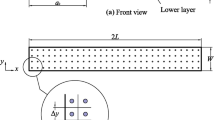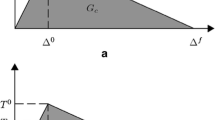Abstract
A new test method was proposed to evaluate the cohesive strength of composite laminates. Cohesive strength and the critical strain energy for Mode-II interlamiar fracture of E-glass/epoxy woven fabrication were determined from the single lap joint (SLJ) and end notch flexure (ENF) test, respectively. In order to verify their adequacy, a cohesive zone model simulation based on interface finite elements was performed. A closed form solution for determination of the penalty stiffness parameter was proposed. Modified form of Park-Paulino-Roesler traction-separation law was provided and conducted altogether with trapezoidal and bilinear mixed-mode damage models to simulate damage using Abaqus cohesive elements. It was observed that accurate damage prediction and numerical convergence were obtained using the proposed penalty stiffness. Comparison between three damage models reveals that good simulation of fracture process zone and delamination prediction were obtained using the modified PPR model as damage model. Cohesive zone length as a material property was determined. To ensure the sufficient dissipation of energy, it was recommended that at least 4 elements should span cohesive zone length.
Similar content being viewed by others
References
BRUNNER A, BLACKMAN B, DAVIES P. A status report on delamination resistance testing of polymer-matrix composites [J]. Engineering Fracture Mechanics, 2008, 75: 2779–2794.
LIU P, YANG Y. Finite element analysis of the competition between crack deflection and penetration of fiber-reinforced composites using virtual crack closure technique [J]. Applied Composite Materials, 2014, 21: 759–771.
JUDT P O, RICOEUR A, LINEK G. Crack path prediction in rolled aluminum plates with fracture toughness orthotropy and experimental validation [J]. Engineering Fracture Mechanics, 2015, 138: 33–48.
DAVIS B, WAWRZYNEK P, HWANG C, INGRAFFEA A. Decomposition of 3-D mixed-mode energy release rates using the virtual crack extension method [J]. Engineering Fracture Mechanics, 2014, 131: 382–405.
QIAN Z D, HU J. Fracture properties of epoxy asphalt mixture based on extended finite element method [J]. Journal of Central South University, 2012, 19: 3335–3341.
DUGDALE D. Yielding of steel sheets containing slits [J]. Journal of the Mechanics and Physics of Solids 1960, 8: 100–104.
BARENBLATT G. The mathematical theory of equilibrium cracks in brittle fracture [J]. Advances in Applied mechanics, 1962, 7: 55–129.
HILLERBORG A, MODÉER M, PETERSSON P E. Analysis of crack formation and crack growth in concrete by means of fracture mechanics and finite elements [J]. Cement and Concrete Research, 1976, 6: 773–781.
NEEDLEMAN A. An analysis of decohesion along an imperfect interface [J]. International Journal of Fracture, 1990, 42: 21–40.
XU X P, NEEDLEMAN A. Numerical simulations of fast crack growth in brittle solids [J]. Journal of the Mechanics and Physics of Solids, 1994, 42: 1397–1434.
NGUYEN V P, KERFRIDEN P, BORDAS S. Two-and three-dimensional isogeometric cohesive elements for composite delamination analysis [J]. Composites Part B: Engineering, 2014, 60: 193–212.
VANDELLOS T, HUCHETTE C, CARRÈRE N. Proposition of a framework for the development of a cohesive zone model adapted to carbon-fiber reinforced plastic laminated composites [J]. Composite Structures, 2013, 105: 199–206.
ZHANG Z J, PAULINO G H. Cohesive zone modeling of dynamic failure in homogeneous and functionally graded materials [J]. International Journal of Plasticity, 2005, 21: 1195–1254.
SONG S H, PAULINO G H, BUTTLAR W G. Simulation of crack propagation in asphalt concrete using an intrinsic cohesive zone model [J]. Journal of Engineering Mechanics, 2006, 132: 1215–1223.
PARK K, PAULINO G H, ROESLER J R. Determination of the kink point in the bilinear softening model for concrete [J]. Engineering Fracture Mechanics, 2008, 75: 3806–3818.
de MORAIS A, PEREIRA A, de MOURA M. Mode III interlaminar fracture of carbon/epoxy laminates using the six-point edge crack torsion (6ECT) [J]. Composites Part A: Applied Science and Manufacturing, 2011, 42: 1793–1799.
ZHAO L, GONG Y, ZHANG J, CHEN Y, FEI B. Simulation of delamination growth in multidirectional laminates under mode I and mixed mode I/II loadings using cohesive elements [J]. Composite Structures, 2014, 116: 509–522.
de MORAIS A. Mode I cohesive zone model for delamination in composite beams [J]. Engineering Fracture Mechanics, 2013, 109: 236–245.
de MORAIS A. Cohesive zone beam modelling of mixed-mode I–II delamination [J]. Composites Part A: Applied Science and Manufacturing, 2014, 64: 124–131.
KHOSHRAVAN M R, MOSLEMI M. Investigation on mode III interlaminar fracture of glass/epoxy laminates using a modified split cantilever beam test [J]. Engineering Fracture Mechanics, 2014, 127: 267–279.
de MOURA M, CAMPILHO R, GONÇALVES J. Pure mode II fracture characterization of composite bonded joints [J]. International Journal of Solids and Structures, 2009, 46: 1589–1595.
LILJEDAHL C, CROCOMBE A, WAHAB M A, ASHCROFT I. Damage modelling of adhesively bonded joints [J]. International Journal of Fracture, 2006, 141: 147–161.
LIU P, ISLAM M. A nonlinear cohesive model for mixed-mode delamination of composite laminates [J]. Composite Structures, 2013, 106: 47–56.
BLACKMAN B, HADAVINIA H, KINLOCH A, WILLIAMS J. The use of a cohesive zone model to study the fracture of fibre composites and adhesively-bonded joints [J]. International Journal of Fracture, 2003, 119: 25–46.
SONG S H, PAULINO G H, BUTTLAR W G. A bilinear cohesive zone model tailored for fracture of asphalt concrete considering viscoelastic bulk material [J]. Engineering Fracture Mechanics, 2006, 73: 2829–2848.
KAFKALIDIS M, THOULESS M D, YANG Q, WARD S. Deformation and fracture of adhesive layers constrained by plastically-deforming adherends [J]. Journal of Adhesion Science and Technology, 2000, 14: 1593–1607.
TURON A, DAVILA C G, CAMANHO P P, COSTA J. An engineering solution for mesh size effects in the simulation of delamination using cohesive zone models [J]. Engineering Fracture Mechanics, 2007, 74: 1665–1682.
ALVAREZ D, BLACKMAN B, GUILD F, KINLOCH A. Mode I fracture in adhesively-bonded joints: A mesh-size independent modelling approach using cohesive elements [J]. Engineering Fracture Mechanics, 2014, 115: 73–95.
PARK K, PAULINO G H, ROESLER J R. A unified potential-based cohesive model of mixed-mode fracture [J]. Journal of the Mechanics and Physics of Solids, 2009, 57: 891–908.
ZOU Z, REID S, LI S, SODEN P. Modelling interlaminar and intralaminar damage in filament-wound pipes under quasi-static indentation [J]. Journal of Composite Materials, 2002, 36: 477–499.
CAMANHO P P, DAVILA C, de MOURA M. Numerical simulation of mixed-mode progressive delamination in composite materials [J]. Journal of Composite Materials, 2003, 37: 1415–1438.
BENZEGGAGH M, KENANE M. Measurement of mixed-mode delamination fracture toughness of unidirectional glass/epoxy composites with mixed-mode bending apparatus [J]. Composites Science and Technology, 1996, 56: 439–449.
ANDERSSON T, STIGH U. The stress–elongation relation for an adhesive layer loaded in peel using equilibrium of energetic forces [J]. International Journal of Solids and Structures, 2004, 41: 413–434.
LEFFLER K, ALFREDSSON K, STIGH U. Shear behaviour of adhesive layers [J]. International Journal of Solids and Structures, 2007, 44: 530–545.
CAMPILHO R, de MOURA M, DOMINGUES J. Using a cohesive damage model to predict the tensile behaviour of CFRP single-strap repairs [J]. International Journal of Solids and Structures, 2008, 45: 1497–1512.
CARLSSON L, ADAMS D F, PIPES R B. Experimental characterization of advanced composite materials [M]. United States: CRC Press, 2002.
HUI C Y, JAGOTA A, BENNISON S, LONDONO J. Crack blunting and the strength of soft elastic solids [J]. Proceedings of the Royal Society of London Series A: Mathematical, Physical and Engineering Sciences, 2003, 459: 1489–1516.
FALK M L, NEEDLEMAN A, RICE J R. A critical evaluation of cohesive zone models of dynamic fracture [J]. Le Journal de Physique IV, 2001, 11: Pr5-43-Pr5-50.
IRWIN G. Plastic zone near a crack and fracture toughness [C]// Proceedings of the Seventh Sagamore Ordance Materials Conference. New York: Syracuse University, 1960, IV: 63–78.
MOËS N, BELYTSCHKO T. Extended finite element method for cohesive crack growth [J]. Engineering Fracture Mechanics, 2002, 69: 813–833.
DÁVILA C G, CAMANHO P P, de MOURA M F. Mixed-mode decohesion elements for analyses of progressive delamination [J]. Proceedings of the 42nd AIAA/ASME/ASCE/AHS/ASC Structures, Structural Dynamics and Materials Conference. Seattle: NASA, 2001.
Author information
Authors and Affiliations
Corresponding author
Rights and permissions
About this article
Cite this article
Moslemi, M., Khoshravan azar, M. Delamination analysis of woven fabrication laminates using cohesive zone model. J. Cent. South Univ. 23, 27–38 (2016). https://doi.org/10.1007/s11771-016-3045-9
Received:
Accepted:
Published:
Issue Date:
DOI: https://doi.org/10.1007/s11771-016-3045-9




